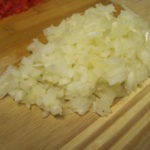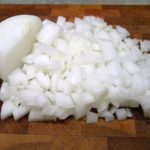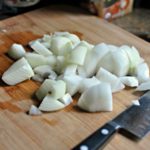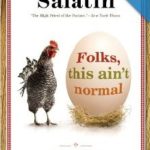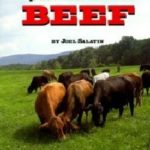LOW CARB FOOD LAGNIAPPES-A LITTLE SOMETHING EXTRA. What is a lagniappe you ask? It is something given as a bonus or unexpected gift. It is a French word and is primarily used in Southern Louisiana. The 13th donut in a baker’s dozen would be considered a lagniappe.
USING SURFACE AREA TO YOUR ADVANTAGE
This is important stuff. As particle size decreases surface area increases.
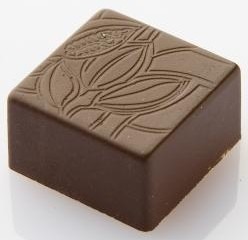 Surface area is nature’s way of making materials more available for exploitation. As Mother Nature has it, most physical and chemical events happen on the surfaces of materials, not in the mass. When you pop a square of chocolate into your mouth, your taste buds sing in response to the chemical reaction that takes place when the flat of the square dissolves on your tongue. Liquid phase chocolate meets solid phase taste bud. In lab lingo the point where chocolate meets tongue is called an interface. Whether you knew that or not, you intuitively know that when it comes to chocolate bars, more surface means more flavor. So you crush the morsel between your molars and the slab’s original six surfaces, suddenly become hundreds of smaller surfaces, much to the glee of the neglected taste buds on your cheeks, lips and every other bud-bearing cranny in your oral cavity. Suddenly your whole mouth is singing like a boy’s choir. Why? Because you created more places for chemical reactions to take place – more interfaces. You increased the surface area of the chocolate by liberating its internal mass. Mmmmmm. Same mass – more surface area-tastes better!
Surface area is nature’s way of making materials more available for exploitation. As Mother Nature has it, most physical and chemical events happen on the surfaces of materials, not in the mass. When you pop a square of chocolate into your mouth, your taste buds sing in response to the chemical reaction that takes place when the flat of the square dissolves on your tongue. Liquid phase chocolate meets solid phase taste bud. In lab lingo the point where chocolate meets tongue is called an interface. Whether you knew that or not, you intuitively know that when it comes to chocolate bars, more surface means more flavor. So you crush the morsel between your molars and the slab’s original six surfaces, suddenly become hundreds of smaller surfaces, much to the glee of the neglected taste buds on your cheeks, lips and every other bud-bearing cranny in your oral cavity. Suddenly your whole mouth is singing like a boy’s choir. Why? Because you created more places for chemical reactions to take place – more interfaces. You increased the surface area of the chocolate by liberating its internal mass. Mmmmmm. Same mass – more surface area-tastes better!
I didn’t make this up and it’s not original but I have always known it as it pertains to food and cooking. http://www.science-communications.com/editorial/nano_technology/scratching_nanos_sweet_surface.html
 Mother Nature’s cookbook says that as particle size decreases surface area increases geometrically. To illustrate, imagine this: first, spill the contents of a five- pound bag of flour on a gymnasium floor and spread it out as thin as possible. Then slice the empty bag open and lay it flat, next to the powdery mess you just made. The surface area of the bag would be equal to the surface area of the flour, if the flour were a solid block instead of a powder. At this point, it should be pretty easy to conclude that the surface area of the flour on the floor would be much larger than that of the laid out bag. If we count the sides and bottoms of each and every flour particle, the difference in surface areas becomes astounding.
Mother Nature’s cookbook says that as particle size decreases surface area increases geometrically. To illustrate, imagine this: first, spill the contents of a five- pound bag of flour on a gymnasium floor and spread it out as thin as possible. Then slice the empty bag open and lay it flat, next to the powdery mess you just made. The surface area of the bag would be equal to the surface area of the flour, if the flour were a solid block instead of a powder. At this point, it should be pretty easy to conclude that the surface area of the flour on the floor would be much larger than that of the laid out bag. If we count the sides and bottoms of each and every flour particle, the difference in surface areas becomes astounding.
So knowing this, it makes sense that though porcini mushrooms are God’s gift to your taste buds, if you turn them to dust it will get them into every nook & cranny of your mouth allowing you to use far less just like dried herbs vs fresh and then rubbing them in your hands to intensify their flavors even further.
Bottom Line: Bigger is definitely not always better.
PORCINI DUST
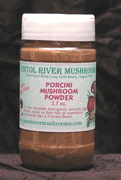 I could not live without this. I use at most 1-1½ teaspoons in any given recipe and it has more flavor-bang for your buck than anything else I can think of. I guarantee it will change your foodie life.
I could not live without this. I use at most 1-1½ teaspoons in any given recipe and it has more flavor-bang for your buck than anything else I can think of. I guarantee it will change your foodie life.
PISTOL RIVER MUSHROOMS right here in Oregon are the real deal and I have been using this brand for many years. The price is a scant 1.69oz. (26.95 when you buy a l pound canister) and is totally worth every penny. The mushrooms are grade A and imported from Italy. Pistol River Porcini Dust or Pistol River Porcini Mushrooms
The reviews on Amazon for OliveNation Porcini Powder are mixed and at 2.75oz. are the lowest AB grade Porcini. Porcini powder can also be purchased through D’Artagnan in Newark, NJ but know this: You can get lost on this website. D’Artagnan services the very finest restaurants in this country and while the quality of their products is incomparable…they are very expensive…so if you do decide to visit this website hold on to your wallet because they have things you cannot buy anywhere else. Their mushroom powder is 3.03 per ounce plus shipping. http://www.dartagnan.com/Dried-Porcini-Mushroom-Powder/MDCPF029-1,default,pd.html
So, always remembering that you get what you pay for, get a good grade A Porcini Powder and your mouth (and your family & friends) will thank you a thousand times. You will see Porcini Dust used in recipes throughout this site.
THE TRULY INCREDIBLE EGG
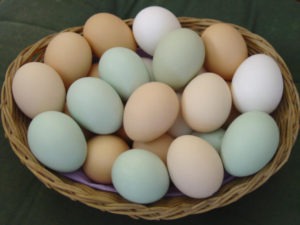 While porcini dust may be the best tasting stuff in the world nothing beats an egg for versatility. Eggs come into this world with a protective film from the hen and never need to be washed. In fact if you wash away the film the egg becomes susceptible to bacteria, will get old much faster, and will begin to dry out. The older the egg the more watery the whites, the flatter the yolks and yes, the easier they are to peel.
While porcini dust may be the best tasting stuff in the world nothing beats an egg for versatility. Eggs come into this world with a protective film from the hen and never need to be washed. In fact if you wash away the film the egg becomes susceptible to bacteria, will get old much faster, and will begin to dry out. The older the egg the more watery the whites, the flatter the yolks and yes, the easier they are to peel.
They say that the folds in a chef’s hat are attributed to the numbers of ways to use eggs. (I have never figured out who “they” are).
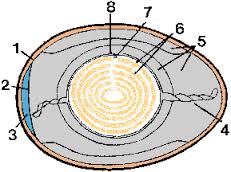 The chalazae are those nauseating little short twisted white cords (#’s 3&4) wrapped around the yolk to keep it in place which always seems to be in the way and difficult to remove. I don’t know about you but biting into a chunk of cooked chalaza in an otherwise smooth custard or Lemon Curd is a total turn off. The reason many recipes call for straining is to remove them but I think it is much simpler to get rid of them before they are incorporated and cooked.
The chalazae are those nauseating little short twisted white cords (#’s 3&4) wrapped around the yolk to keep it in place which always seems to be in the way and difficult to remove. I don’t know about you but biting into a chunk of cooked chalaza in an otherwise smooth custard or Lemon Curd is a total turn off. The reason many recipes call for straining is to remove them but I think it is much simpler to get rid of them before they are incorporated and cooked.
Eggs improve the texture of custards, act as binders for meats and Carbalose Flour Bread Stuffing, emulsify fats and liquids, add volume to baked goods, and make pastries shine. Plus, they’re nutritionally complete and delicious. Good eggs from good pastures can be found all over the country, and they’re about the best bang for your buck in terms of high-quality protein you can get. A meal of eggs will always cost far less than any meat dish. Alas, man cannot live by eggs alone but we can darn sure use them in hundreds of ways. The coolest thing of all is that now we all know we can eat eggs all day long everyday…because they are good, good, good for us.
To make the best and most successful omelets & scrambled eggs you need to break and beat your eggs and then let them rest in the refrigerator for at least several hours and over night is best. In the restaurant biz back in the 70’s & 80’s we used to do this. Now, the restaurant police make you break and scramble your eggs individually or whatever constitutes a serving so there is no “rest period”. The scrambled eggs & omelets of today are not nearly as tender and good as yesteryear-how sad.
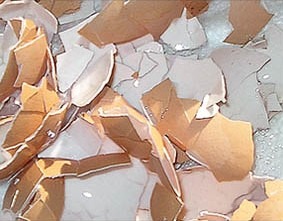 Eggshells. Did you know that no matter how small a piece of eggshell is, it will not float? Well they don’t so any shards of shells will always sink and will be the only thing left in your bowl after you pour your eggs into a pan. Try it and see.
Eggshells. Did you know that no matter how small a piece of eggshell is, it will not float? Well they don’t so any shards of shells will always sink and will be the only thing left in your bowl after you pour your eggs into a pan. Try it and see.
Funny Personal Story: I worked in a very fast breakfast-lunch restaurant in Telluride, CO in the mid 80’s and my station on the line was the “egg” person. At the end of the day we had to have a full case of beaten eggs ready for the following morning. Loren and I would each take half the case (15 dozen each) and “race” to see who could finish the fastest. We would each hold 2-3 eggs in each hand, crack them on the side of a huge mixing bowl and have it. At times a whole shell could be dropped in with the eggs. Did we sweat the small stuff? Hell No. The following day it was my job to pour the liquid eggs into manageable bowls to use on the line and some days you wouldn’t believe the shells at the bottom but for the thousands and thousands of omelets and scrambled egg dishes I put out not once, not one time, did one come back because it had a shell piece in it. Alas, the process of “pooling eggs” has passed into history.
ONIONS
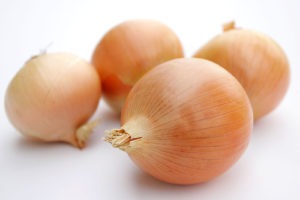 Eating low carb, for me, has never been about a diet and has been everything about my way of life. The word “diet” denotes something that begins and ends vs “a way of life” which begins but definitely has no ending.
Eating low carb, for me, has never been about a diet and has been everything about my way of life. The word “diet” denotes something that begins and ends vs “a way of life” which begins but definitely has no ending.
For a low carber onions in all but the smallest amounts have considerable carbs so this is what I mostly do. I cut them into a very fine dice-like mince and better yet as you will find in some of the recipes, I grate them. Making anything as small as possible allows for the greatest surface area, hence more intense flavor. (See USING SURFACE AREA TO YOUR ADVANTAGE) A tablespoon of grated onion will give you the flavor of about ¼ C of small dice or about ½ C of large dice. All the flavor but not all the carbs.
On occasion I use different cuts of onions and when you see them in a recipe here is what they look like.
- Minced
- Diced
- Chopped
- Slivered
- Grated
The difference between sweating and sautéing onions is your cooking temperature. Sweating is a medium heat until translucent and sautéing is higher heat until they just begin to brown and caramelize.
I use the green tops of spring onions very liberally.
CRANBERRIES
What to say. Cranberries, and sour as they are, have a relatively high carb content but eaten in moderation can be a terrific meal accompaniment Cranberry Orange Relish and even make for some great desserts. Cranberry Orange Mousse I buy about 15-20 lbs of cranberries in October-November and fill 1 gallon freezer bags for use all year round. They freeze beautifully and the only difference between fresh and frozen cranberries is how you process them. Below is an Oregon company you can directly order cranberries from and they will not cost you an arm and a leg. Last year Carol charged 1.00 a lb + shipping. I don’t know what they will be this year but her prices compare to 3.00-4.00 for a 12oz. bag in a grocery store. Think about it-90 acres of beautiful red cranberries. The Russell family has been on this farm since 1876 and growing cranberries since the mid-30’s. Can you imagine starting a business in the middle of the Depression that takes 5 years to bear fruit? I hope the next time you think about buying cranberries you will buy from this small grower and not the all powerful Ocean Spray and if you call, Carol is the one most likely to answer. Orders are taken in September and October. See a very short video of the Bandon Cranberry Company here.
 Carol Russell
Carol Russell
Bandon Cranberry Company
89358 Cranberry Lane
Bandon, Oregon 97411
(800) 293-0510
(541) 347-4423
(866) 814-0803Fax
SAUTEING MUSHROOMS & VEGETABLES
 How many times have you begun to sauté mushrooms only to have them begin stewing in their own juices? The secrets to good sautéed mushrooms are: room temperature, never wash them, do them on high heat and don’t slice them too thinly. When I am doing mushrooms I use a combination olive oil and butter and get it very hot. Watch the butter and let it get really brown before adding the mushrooms. The reason you never wash mushrooms is because from the moment they are harvested they begin to deteriorate. They are picked, sorted by size, sent to a produce distributor and then on to your local grocery where you finally buy them. Now I will say it right here that Alton Brown and I disagree about washing mushrooms. He says it’s OK to wash them-I say no, brush them, and only if they really need it. He says you can store them in a paper bag-I say no-buy them fresh and cook them soon, they get leathery in a paper bag. We do agree on one thing-don’t overcrowd your pan. Put your mushrooms in the hot, hot fat mixture and do not move, mix or stir for 3-4 minutes. As long as your shrooms are sizzling you are OK. The idea is that as the moisture is coming out, it is also evaporating just as quickly so I say, why wash them when the idea is to get rid of the moisture as quickly as possible? As they begin to get their nice darker brown on, quickly turn as many as you can and leave them alone again. If, they do get to stewing all is not lost but you will need to let the liquids evaporate before any browning will occur.
How many times have you begun to sauté mushrooms only to have them begin stewing in their own juices? The secrets to good sautéed mushrooms are: room temperature, never wash them, do them on high heat and don’t slice them too thinly. When I am doing mushrooms I use a combination olive oil and butter and get it very hot. Watch the butter and let it get really brown before adding the mushrooms. The reason you never wash mushrooms is because from the moment they are harvested they begin to deteriorate. They are picked, sorted by size, sent to a produce distributor and then on to your local grocery where you finally buy them. Now I will say it right here that Alton Brown and I disagree about washing mushrooms. He says it’s OK to wash them-I say no, brush them, and only if they really need it. He says you can store them in a paper bag-I say no-buy them fresh and cook them soon, they get leathery in a paper bag. We do agree on one thing-don’t overcrowd your pan. Put your mushrooms in the hot, hot fat mixture and do not move, mix or stir for 3-4 minutes. As long as your shrooms are sizzling you are OK. The idea is that as the moisture is coming out, it is also evaporating just as quickly so I say, why wash them when the idea is to get rid of the moisture as quickly as possible? As they begin to get their nice darker brown on, quickly turn as many as you can and leave them alone again. If, they do get to stewing all is not lost but you will need to let the liquids evaporate before any browning will occur.
 If your mushrooms are really that dirty (it’s only sterile peat for Pete’s sake) then use a mushroom brush. Yes, I mean a brush in the shape of a mushroom. I have had mine for probably 25 years and it looks just like the picture.
If your mushrooms are really that dirty (it’s only sterile peat for Pete’s sake) then use a mushroom brush. Yes, I mean a brush in the shape of a mushroom. I have had mine for probably 25 years and it looks just like the picture.
 The same principles apply when sautéing vegetables since most all vegetables are mostly water. Never salt your vegetables until just before you are ready to serve them because though they may seem dry they are not and salt draws out moisture.
The same principles apply when sautéing vegetables since most all vegetables are mostly water. Never salt your vegetables until just before you are ready to serve them because though they may seem dry they are not and salt draws out moisture.
SWEETENERS
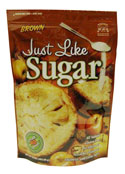
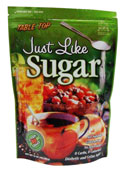
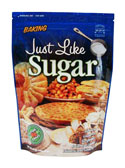 Now here is a subject I could probably discuss with a lot of people for a long time. My sweeteners of choice are all three of the Just Like Sugar‘s and EZ-Sweetz. I have also now begun mixing them because each one brings something a little different to the table. I tried to like Stevia but it was a total no-go.
Now here is a subject I could probably discuss with a lot of people for a long time. My sweeteners of choice are all three of the Just Like Sugar‘s and EZ-Sweetz. I have also now begun mixing them because each one brings something a little different to the table. I tried to like Stevia but it was a total no-go.
![]() I know lots of you guys out there are going to disagree with me about using Splenda and I feel, after reading for days about artificial sweeteners of all kinds, that I am totally comfortable with this product. I DO NOT USE granulated Splenda because it has 24g carbs per cup and these carbs are totally unneeded-they are for people to comfortably think they are really kinda using real sugar. Please read Sugar Alcohols And Why I Don’t Use Them
I know lots of you guys out there are going to disagree with me about using Splenda and I feel, after reading for days about artificial sweeteners of all kinds, that I am totally comfortable with this product. I DO NOT USE granulated Splenda because it has 24g carbs per cup and these carbs are totally unneeded-they are for people to comfortably think they are really kinda using real sugar. Please read Sugar Alcohols And Why I Don’t Use Them
DESSERT SIZE
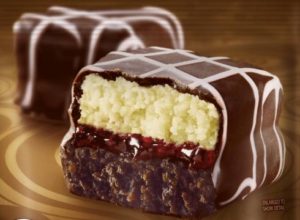 Dessert is the essence of what a lagniappe means. It should be its own little lagniappe which translated means “a little something extra” as a thank you for your patronage.
Dessert is the essence of what a lagniappe means. It should be its own little lagniappe which translated means “a little something extra” as a thank you for your patronage.
Somehow here in the good ole US of A we got to the fact that desserts should somehow be a major pig out of 500-700 calories and 60g-85g carbs. Example: 1/8th slice of a 9” pecan pie is 500 calories and 64g of carbohydrate. WHAT? And I can tell you that nobody eats 1/8th of a pie-it is usually 1/6th which would translate to about 675 calories and 85g carbs. WHAT? I believe dessert should be served 15-20 minutes after eating to allow the sensation of “satiety” to settle in completely. If you are truly eating LCHF the feeling of fullness from the consumption of fats and proteins will have occurred in this time period and should easily carry you to your next meal.
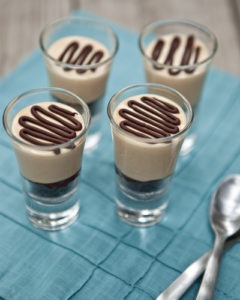 One of the things I like about Carolyn Ketchum is that when she figures her desserts she makes them very small portions. Now if you decide to eat more than a couple of bites that’s your business but here’s the deal. If you have just had a satisfying meal why on earth would you force down more than a couple succulent bites of dessert?
One of the things I like about Carolyn Ketchum is that when she figures her desserts she makes them very small portions. Now if you decide to eat more than a couple of bites that’s your business but here’s the deal. If you have just had a satisfying meal why on earth would you force down more than a couple succulent bites of dessert?
These three pictures of pies in a cake are abominations and they are really served in some restaurants. The third one has 1800 calories PER SLICE. WHAT? ARE YOU KIDDING ME? In my book 1800 calories in one serving of any dessert can be called nothing short of obscene.
EATING SLOWLY
Wow, this has always been a toughie for me. Having been in the food business most of my working life you learn to eat quickly and drink cold, or at best, lukewarm coffee…and with cream and sugar…forget about it. By the time you try to add anything to black coffee you can’t get to the first sip. If you don’t eat quickly-you end up not eating at all. Eating slowly is very important and it will also help you eat less. Since I eat LCHF it takes a little time for your brain to catch up with what you are putting in your mouth and if you eat too much too quickly you will end up feeling uncomfortably full for the rest of the day/evening.
PRE-HEATING IN THE MICROWAVE
Use your microwave to its best advantage. I use mine to heat casseroles quickly or melt cheese on/in something and then finish in the oven or the toaster oven. This will save you lots of electricity use and lots of time.
FUTURE COOKING
If something you are preparing from scratch for two people takes 15 minutes and cooking for six people takes 20 minutes then why not cook for six? In the hustle & bustle of everyday life we often enough use the excuse that we don’t have the time to cook and one of the ways to get around this is to what I call “future cook” and here is a giant plus-you only have to do cleanup, pots & pans, and dishes once. A couple of examples might be:
1. Mashed Cauliflower. It takes just as long to cook one head of cauliflower as it does three. When you are finished mashing it scoop it into small film lined bowls and freeze them and the next time you want cauliflower it is there waiting for you.
2. Yogurt. For those of you who do make your own yogurt why not make it by the gallon? We eat Yogurt, Granola, and blueberries every morning for breakfast and by the gallon it lasts us 18-20 days. One quart or one gallon-they take the same time to incubate.
3. Mushrooms. It takes almost the same amount of time to cut and sauté a mess of mushrooms as it does for one meal so why not cook a bunch, divide them into 2-3 oz. portions and freeze them. Voila, ready at a moments notice.
I future cook many of the recipes on this site plus many more and even though I am retired, since I do cook everything we eat from scratch, it is sometimes difficult even for me to keep up. Future cooking requires nothing more than planning and then using a day devoted to cooking or, if you are retired, keeping things on a rotating schedule.
DJ Foodie is a guy I pay attention to. He does not know me from Adam but here is a terrific post he just made about cooking for two (long) days and then having enough food for 30 days. What a terrific idea and what I am talking about.
LARD & TALLOW-AND YES I RENDER MY OWN
TALLOW-BEEF
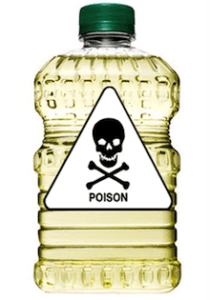 This may gross some of you out and I could care less. I do not use oils at all (except olive & coconut). 1. 90% of them are GMO. 2. They go rancid. 3. They don’t taste good. 4. Are mostly Omega 6’s with almost no Omega 3’s to accompany them.
This may gross some of you out and I could care less. I do not use oils at all (except olive & coconut). 1. 90% of them are GMO. 2. They go rancid. 3. They don’t taste good. 4. Are mostly Omega 6’s with almost no Omega 3’s to accompany them.
Tallow has about a 6:3 ratio so if I am going to get Omega 6’s (which of course we all do) I’ll do it as a 2:1 ratio (optimal) and not something as ridiculous like 20-25:1 or even higher and I will get it from something good. If I die from fat overload (I won’t) I at least want it to taste good. Anyway, I don’t sit and eat this by the spoonful but when I fry foods, which is not all that often, this is what I use and because of its stability under heat I am able to use it several times. If you don’t remember the 60’s when everything was fried in beef fat then you don’t have any idea how good fried food can be and my Eggplant French Fries are a terrific example. They are to die for.
Originally, when we began grading beef it was based on the amount of fat on the carcass which could be as much as 200 lbs. Every household in America used it for cooking, frying, lubricating metals, and making soap & candles. It has often been dubbed liquid gold. Sadly, today most of it goes to biodiesel production, feed for animals or uses other than eating.
Tallow is ridiculously easy to render. I do 12 lbs. of ground like hamburger fat in the oven, it melts in about 30-45 minutes, and I have enough to fill 2 coffee cans.
LARD-PORK
Basically same as above.
The absolute CRAP to stay away from is ALL TRANSFATS AND ALL VEGETABLE OILS.
“Fat gives things flavor.”
― Julia Child
SHRIMP
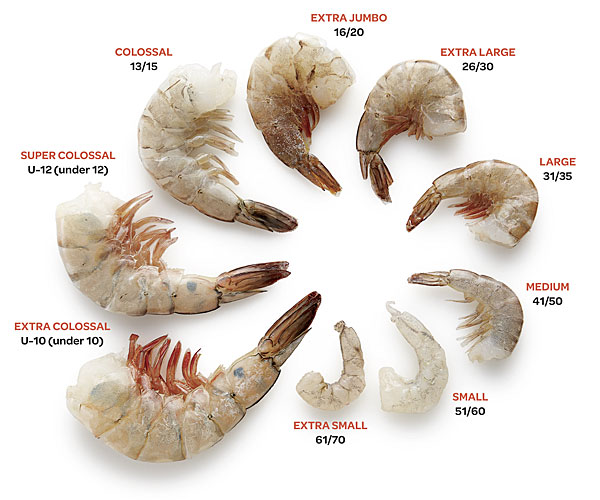 The most important thing to know about shrimp is how they are sized. Have you seen grocery store ads for “JUMBO” shrimp? Well there is a “jumbo” size shrimp (not pictured) and they are anything but-they are 21-25 per pound and when shelled and cooked it takes about 9-10 or more to feed the average person. The ideal size shrimp is a U-15 or Colossal-about 13-15 per pound and they are difficult to find. I get mine at Costco. Pictures are not full size.
The most important thing to know about shrimp is how they are sized. Have you seen grocery store ads for “JUMBO” shrimp? Well there is a “jumbo” size shrimp (not pictured) and they are anything but-they are 21-25 per pound and when shelled and cooked it takes about 9-10 or more to feed the average person. The ideal size shrimp is a U-15 or Colossal-about 13-15 per pound and they are difficult to find. I get mine at Costco. Pictures are not full size.
Shrimp Size Chart Oh, those pesky little shrimp. Easy to cook and so easy to over cook and, how oh how, do you keep them from curling? The short answer is to sever the stringy swimming muscle that powers all the legs on their underbellies by taking scissors and cutting into each segment about ¼” and then carefully straightening them. This will go a long way. As you start cutting you will see the muscle as a very thin white cord.
Oh, those pesky little shrimp. Easy to cook and so easy to over cook and, how oh how, do you keep them from curling? The short answer is to sever the stringy swimming muscle that powers all the legs on their underbellies by taking scissors and cutting into each segment about ¼” and then carefully straightening them. This will go a long way. As you start cutting you will see the muscle as a very thin white cord.
Shrimp is the most popular seafood eaten in this country and virtually none of it comes from US waters. It is farmed (in huge ponds) and comes from as far as Ecuador, Brazil, Thailand and Vietnam. The average shrimp farm lasts about 7 years before diseases wipe them out. Parasites and the use of hefty doses of antibiotics, disinfectants, and pesticides take their toll over time. China’s shrimp industry was all but wiped out and has never really recovered.
Umm, I could go on and on about the shrimp we eat (me included) and I am not into making anyone sick thinking about it. I do try to eat as much organic as I can and after reading Joel Salatin’s books I don’t really have much faith in the whole US Organics programs.
GET IN YOUR KITCHEN & COOK & EXPERIMENT & FAIL or…how to get your husband to sweetly take you out for dinner.
There are a gazillion stories of famous people that have come into success through “failure”. This was just recently Gingerbread Waffles and Milk Chocolate Candy was awhile ago.
“The only real stumbling block is fear of failure. In cooking you’ve got to have a what-the-hell attitude.”
― Julia Child
“Once you have mastered a technique, you barely have to look at a recipe again”
― Julia Child
You have all heard the old saying “you can’t make an omelet without first breaking the eggs” and this is true of cooking in general and failure is inevitable. Whether you are going LCHF, Paleo, or through some other eating change you are going to have to break some eggs.
DARE TO BE DIFFERENT i.e. JOEL SALATIN
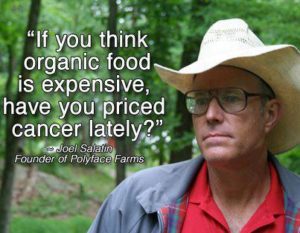 “When faith in our freedom gives way to fear of our freedom, silencing the minority view becomes the operative protocol.”― Joel Salatin, Everything I Want To Do Is Illegal: War Stories from the Local Food Front
“When faith in our freedom gives way to fear of our freedom, silencing the minority view becomes the operative protocol.”― Joel Salatin, Everything I Want To Do Is Illegal: War Stories from the Local Food Front
What to say about Joel Salatin. Joel Salatin is my all time, all around capitalized HERO. I can’t think of anything he has said or written that I could much disagree with and/but…I have not read everything-maybe there is something somewhere. Just so you know, Joel Salatin is that crazy Virginia farmer featured in Michael Pollans book The Omnivores Dilemma and the documentary Food Inc.
 A year and a half into my diabetic low carb life when I came across the Julian Bakery and their falsely labeled low carb breads, little did I know I was about to embark on the most exciting ride of my life and in 66 years I have been on some pretty exciting rides. I had no idea I would catch a crook, be sued by the SOB and write a website-which people would actually read. So when Heath Squier and the Julian Bakery came across my life I did what I have always done-hit him head-on. I have not been afraid of many things in my life and I am certainly not afraid of Heath Squier.
A year and a half into my diabetic low carb life when I came across the Julian Bakery and their falsely labeled low carb breads, little did I know I was about to embark on the most exciting ride of my life and in 66 years I have been on some pretty exciting rides. I had no idea I would catch a crook, be sued by the SOB and write a website-which people would actually read. So when Heath Squier and the Julian Bakery came across my life I did what I have always done-hit him head-on. I have not been afraid of many things in my life and I am certainly not afraid of Heath Squier.
I have pretty much always met life head-on and diabetes has been no exception. OK, so now I have diabetes-let’s read and learn as much as I can, apply some, discard some and try to find some small balance.
Any of you reading on this site, please try not to be afraid of anything. I know it can be difficult at times and I believe adversity makes us all stronger.
You know, when I decided after my professional foodie chefy days to make quilts for a living it never occurred to me that I might fail. Despite the numbers of people who said there are a million people making and trying to selling quilts and they can barely give them away so what makes you think you can sell yours? Well, I did sell my quilts-for lots of money. People realized they had never seen quilts like mine and that they had been looking forever to find a quilt that would actually fit their bed. The first time I sold a quilt it was to someone in New York who subsequently purchased three more. I even sold a quilt to someone famous. In my mind failure wasn’t a remote possibility and all this despite the facts that to this day 1. I have never taken a quilting lesson, 2. I have never taken a quilting class, and 3. I do not own one quilting book. I wouldn’t know how to follow a pattern in a book if my life depended on it. Click any picture to enlarge or you can see lots more at www.kingsizequilts.com
Don’t be afraid to stick out and stick up for what you believe in. If you have never heard the name Joel Salatin now that you have, you will probably see his name begin to pop up from time to time. I even Google Alert him.
Below are eight of the books Joel Salatin has written and most of the titles show his thinking may not be anywhere near what most of us call conventional but to me he makes total sense. You may visit him at http://www.polyfacefarms.com/ and know this: Joel Salatin knows what it is to be free and he lives his freedom every day. Joel is courageous, Joel is defiant and Joel is a dying breed.
Ronald Reagan famously said, “Trust but Verify”. At the signing of the INF Treaty, his conterpart Mikhail Gorbachev responded: “you repeat that at every meeting,” to which Reagan answered: “I like it”…I like it too.



